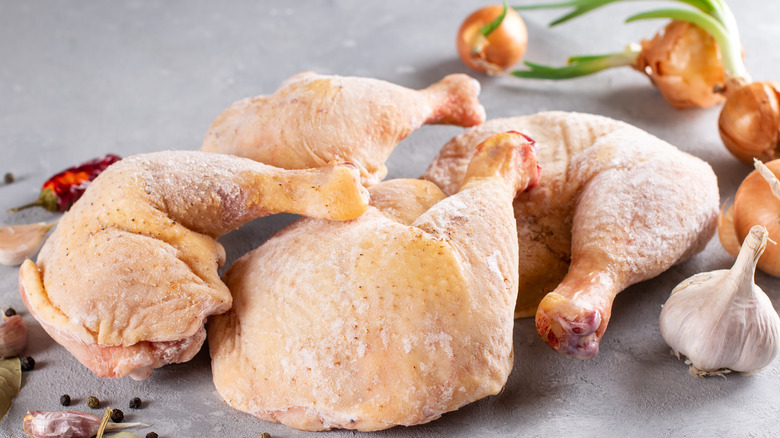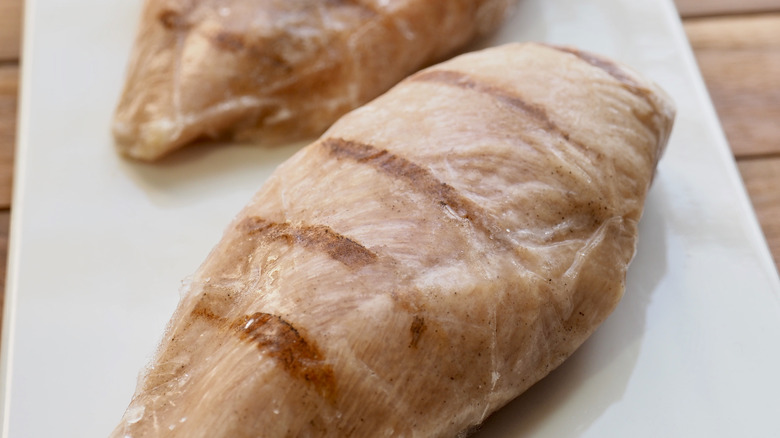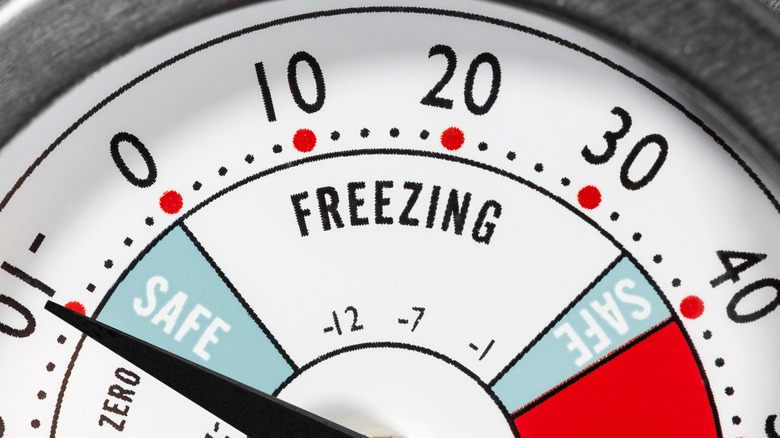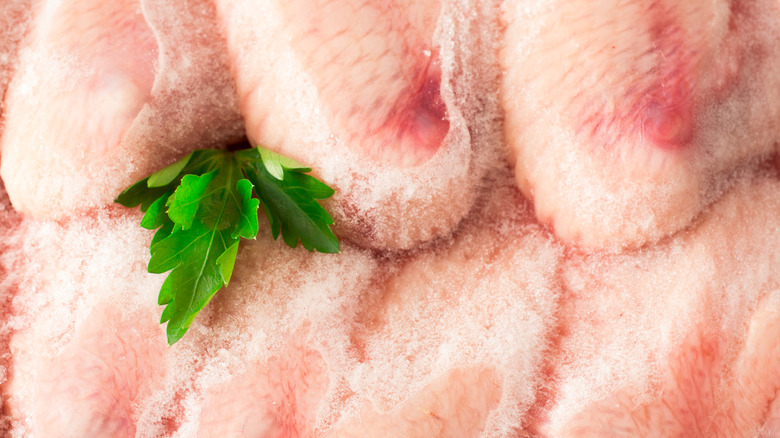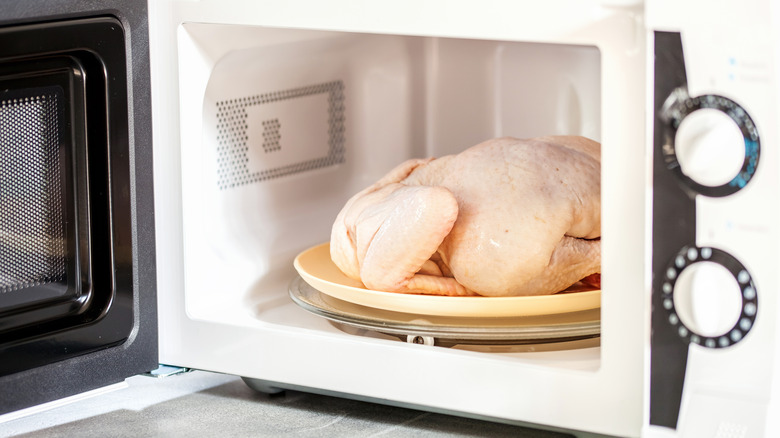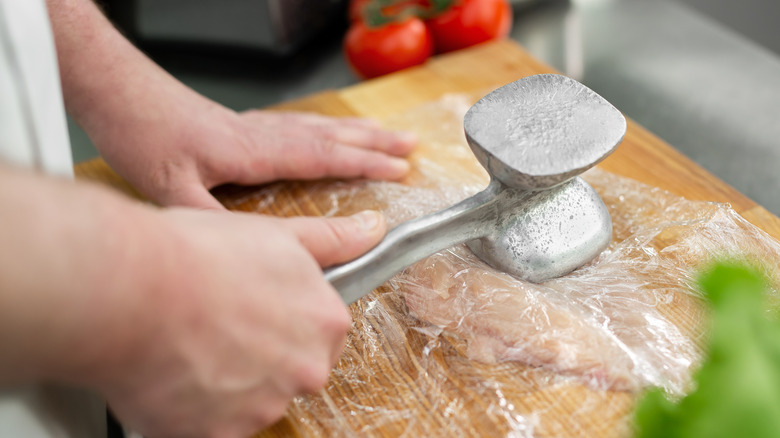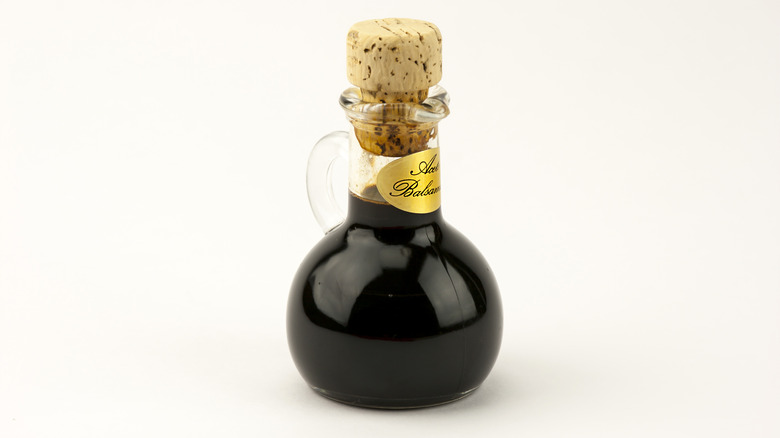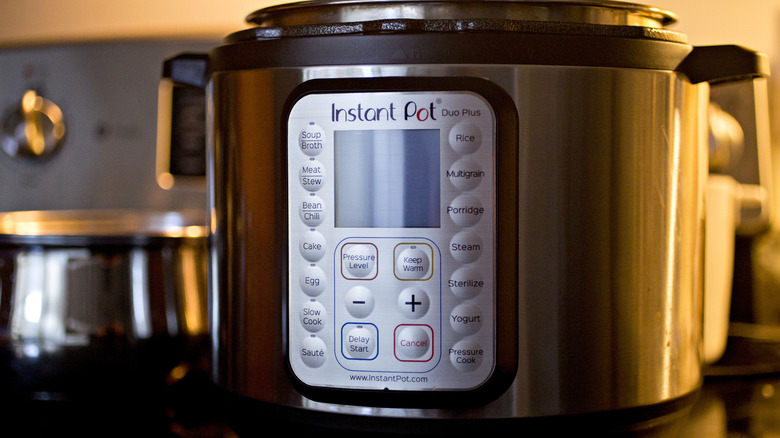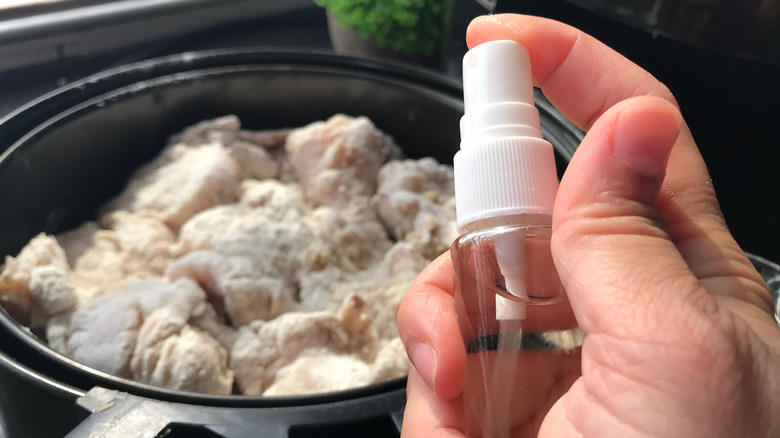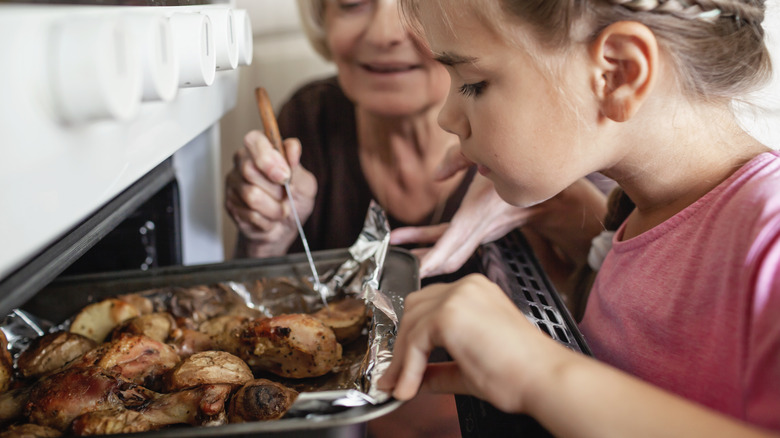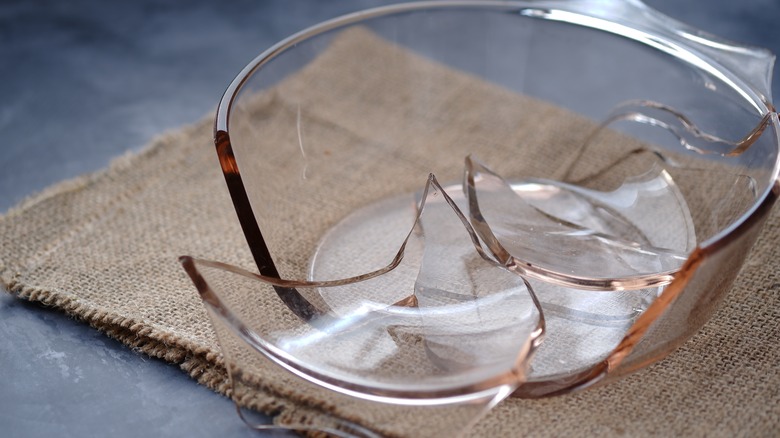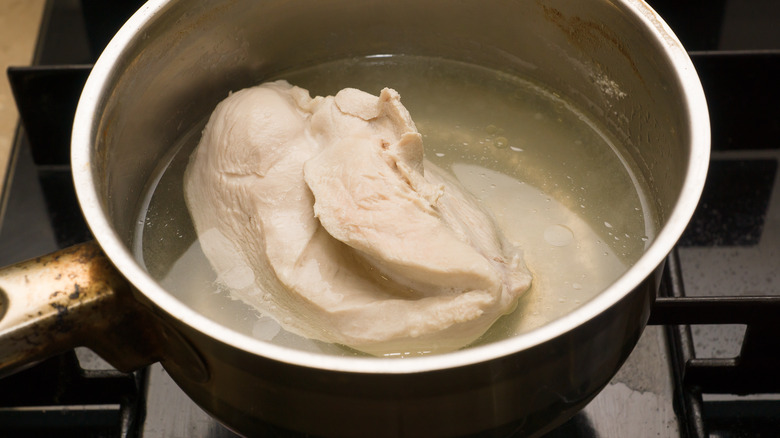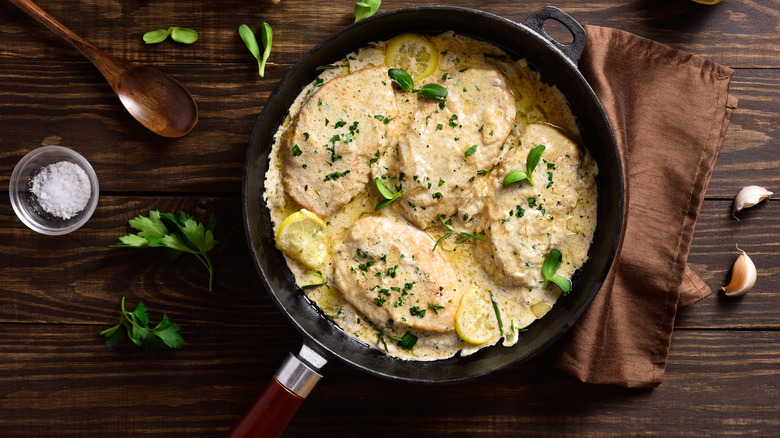The Frozen Chicken Tricks You'll Wish You Knew Sooner
Knowing a few frozen chicken tricks can help improve the flavor of your chicken and save you time in the kitchen. It's always disappointing to have to throw away freezer-burned chicken or end up with dry, rubbery chicken. So, it's essential to know what you're doing wrong from store to freezer and freezer to plate to improve your overall chicken quality.
From freezing to thawing to cooking, we'll give you our best tricks to have you making better chicken in no time. Did you know that you don't even have to thaw frozen chicken before you cook it? It's true. We'll also explain why your glass casserole dish might shatter if you do decide to bake your chicken in it when it's frozen. So, get ready to take your frozen chicken from just okay to tasty and moist with just a few easy tips you'll wish you knew a long time ago.
There's a way to prevent chicken from sticking together when you freeze it
Buying a big pack of chicken and freezing it yourself can often save money. However, if the pieces all stick together when you freeze them, you can end up needing to thaw more than you want to use. The easiest way to prevent this problem is to freeze raw or cooked chicken in individually portioned freezer bags or vacuum-seal bags. Add only as much as you or your family will need for one meal.
It's also possible to freeze your chicken together in one large freezer bag. One trick to prevent pieces from sticking involves pre-freezing them individually before adding them to the bag so they don't stick together. You've seen this method in action if you've ever purchased a large bag of frozen raw chicken, chicken nuggets, or chicken fingers. The easiest method is to place wax paper or parchment paper on a tray or cookie sheet followed by chicken pieces so they don't touch. Then, place the tray in your freezer for a few hours before putting the chicken pieces together into a single plastic freezer bag for the rest of their frozen lives (via 365 Days of Crockpot).
Another method to prevent them from sticking together is to add foil, waxed paper, or parchment paper between each piece of chicken. The pieces may stick slightly to the paper, but they will unloosen fairly quickly once they've thawed slightly (via Pro Family Chef).
Using the right freezing methods can make chicken taste better later and prevent freezer burn
Freezing inevitably decreases the quality of meat, no matter how you do it. Food scientist Harold McGee explains in the book "On Food and Cooking" that as raw chicken freezes, ice crystals from the meat's moisture form and expand. Then, when you thaw your chicken, more fluids than usual leak out, resulting in drier chicken as you cook it. Luckily, you can minimize the loss of moisture if you flash-freeze the meat at very cold temperatures. The faster you freeze the chicken, the smaller the ice crystals will be. You also want to ensure the chicken stays at a low temperature so that more ice crystals don't have a chance to form. For home freezers, you want to keep them as close to 0 degrees Fahrenheit as possible.
McGee also explains that freezer burn happens when water sublimates in the freezer -– "the equivalent of evaporation at below-freezing temperatures." Sublimation results in an exposed layer of meat that becomes freeze-dried and changes texture and flavor. McGee says you can avoid freezer burn if you wrap the chicken air-tight with water-impermeable plastic wrap. Buying a vacuum sealer or vacuum-sealing meat in a water bath can assist with the process.
There are a few ways to separate pieces of chicken that have been frozen together
Despite our best intentions, most of us have placed chicken into the freezer without bothering to separate it into portions. Cooking experimenter Veronica Fletcher from Pantry and Larder says that butchers sometimes cut frozen chicken apart with a meat saw, but most home cooks don't own such a fancy gadget. And trying to separate chicken with a knife when it's frozen solid is risky. So, if you can't easily pull the pieces apart, you're probably going to have to partially thaw the chicken first.
USDA's Food Safety and Inspection Service says you have three options to safely thaw your chicken. Fletcher says the easiest way is to keep the chicken in the bag and run cold water over the places you want the chicken to separate. Once it's starting to melt, you can use a butter knife to pry apart the pieces. The next best method is to defrost meat in the microwave for a few seconds at a time, checking to see if the ice has melted enough to separate the pieces. The slowest method is to let the chicken sit in the refrigerator until it can be separated. Once you've gotten the pieces you want, you can refreeze the rest. Fletcher said she likes to pat her chicken dry before refreezing to avoid freezer burn.
Unfortunately, a 2013 study shows that the overall chicken quality suffers every time you thaw and refreeze it.
There are three safe ways to thaw raw frozen chicken
Some of the biggest mistakes people make with frozen chicken involve how they defrost it before cooking it. To avoid the bacteria on your chicken multiplying to dangerous levels, you should never thaw chicken at room temperature in the kitchen. The USDA says chicken can be safely thawed in the microwave, in the refrigerator or in cold water.
A 2021 study indicates that thawing chicken in cold water results in the best flavor. The USDA says you will need to set a timer to remind yourself to change out the water every 30 minutes. It should only take an hour to thaw a pound of boneless chicken and two or three hours to thaw a whole chicken.
The next best way to thaw chicken is in the microwave. A 2011 study showed that 250 watts is the best power level to prevent losing too much moisture and affecting meat quality. However, the USDA warns that you'll need to cook chicken immediately after thawing because some of the meat will have become fairly warm, inviting bacterial growth if left uncooked.
The method that will take the longest and result in the lowest-quality flavor (per the above-mentioned study) is thawing in the refrigerator. The USDA says you should expect frozen chicken to take a day or two to thaw in the fridge. Then, you have another day or two to use it or refreeze it.
Tenderizing thawed chicken before cooking makes it more moist and tender
In the book "On Food and Cooking," food scientist Harold McGee explains that moisture loss is inevitable when it comes to freezing chicken. The jagged edges of ice crystals poke holes into the chicken as it freezes, which allows moisture to ooze out as it defrosts and cooks. So, if you've found frozen chicken to be tough and dry by the time it gets to your plate, using a chicken preparation method that results in moist chicken can help. Tasting Table suggests pounding chicken into uniformly flat pieces to tenderize it. This process also helps all the chicken pieces cook at the same rate.
Tasting Table says you should wrap the chicken in wax paper or plastic wrap before pounding it with a meat mallet to prevent raw chicken from splattering all over your kitchen. If you don't have a meat mallet, look around your kitchen for something else that can do the job, like a rolling pin. Even the bottom of a jar can do the trick. In the end, you should be left with pieces of chicken that are one-quarter to one-half inch thick. And your chicken should end up with more moisture than it would otherwise have.
Adding balsamic vinegar to chicken as it defrosts helps tenderize it
One game-changing trick that makes chicken taste better is adding balsamic vinegar as it defrosts. Sure, there are other types of acid like lemon juice or apple cider vinegar, but chef Rich LaMarita of the Institute of Culinary Education is of the opinion that every marinade should have balsamic vinegar in it. He likes balsamic vinegar instead of other acidic options because of its complex flavor that adds richness and sweetness to meat. Not only does balsamic vinegar make chicken taste better, but the acid in it also helps tenderize meat. In the book "On Food and Cooking," food scientist Harold McGee explains that acidic marinades allow meat to hold onto moisture as they break down the muscle tissue.
Of course, balsamic vinegar is going to roll right off of frozen chicken. However, you can add it to the bag or other container in which you're thawing your chicken. Then, the chicken can start to absorb the vinegar as it thaws. As the chicken defrosts, you may need to add more marinade so that it is touching the surface of the chicken and can be absorbed more easily.
You don't have to thaw your chicken before placing it in an instant pot
The first moment you realize you can add frozen chicken (and other frozen foods) straight into your instant pot without thawing is a revelation. As your instant pot heats to get up to pressure, it will begin the process of thawing the chicken. Then, the cooking process finishes the job. So, you can add frozen chicken to whatever chicken instant pot recipe you have (like chicken and rice or creamy garlic chicken) and expect it to come out perfectly at the end of the cooking process.
If you're cooking chicken alone in the instant pot without other ingredients, you'll want to add at least a cup of some liquid like water or broth before beginning the cooking process. Then season the chicken however you want. Once you have your frozen chicken in the pot with the lid closed and valve sealed, just hit the "poultry" button and let the instant pot do its magic. If you don't have a poultry button, cook the meat on high pressure for 10-12 minutes with a natural pressure release (via Northern Yum).
You can cook frozen chicken in an air fryer
You've likely prepared frozen, pre-cooked chicken fingers and nuggets in your air fryer before. But did you realize that you can also cook frozen raw chicken in an air fryer? Northern Yum suggests spraying the frozen meat with a little oil and adding seasonings before cooking it at 360 degrees Fahrenheit for 10 minutes on each side. Cooking times will vary based on your air fryer, so keep a meat thermometer handy to ensure it has reached an internal temperature of at least 165 degrees Fahrenheit.
Using an air fryer can be tricky if you have seasonings or sauces that you don't want to fly around in the air. Luckily, most air fryers also have a "bake" setting that you can use just as you would your oven for baking without all the air. However, it's important to note that you should reduce the cooking temperature of your recipe by 25 degrees Fahrenheit and cut the baking time by 20% (via Bake Starters). But wait! The USDA says you need to add 50% more time when baking frozen chicken. So, be sure to keep the extra cooking time in mind before adding ingredients other than chicken. Use your meat thermometer to ensure the chicken gets thoroughly cooked.
You can bake frozen chicken in the oven
Before you put frozen chicken in the oven, remember that it takes 50% longer to bake (via USDA). For example, if you're making a simple baked chicken breast recipe that normally bakes at 400 degrees Fahrenheit for 25 to 30 minutes, you'll need to bake it for 12.5 to 15 minutes longer. Thus, the total cooking time will be up to about 45 minutes. If you have extra ingredients in your recipe, like veggies, you may consider adding them later so that they're cooking only as long as the original recipe suggests. And if you're adding a sweet sauce like barbecue or a honey-based one, wait until the end of the cooking period so that you don't end up burning it and ruining your chicken after all that time.
Since different areas of your oven can cook faster than others, you'll want to check all the pieces of chicken individually so that you don't get any frozen, bacteria-laden surprises on your plate. The USDA says that the internal temperature of the chicken should reach 165 degrees Fahrenheit to be safe to eat.
You'll want to choose a pan that's not made of glass when baking frozen chicken
If you've ever added frozen food to a glass dish, only to have it explode inside the oven, you'll never do it again. Not only is it a pain to clean, but you'll also end up losing both your dish and your dinner. The New York Times Wirecutter service talked with the former chief scientist from the Corning Museum of Glass, Jane Cook, Ph.D., about the glass-shattering phenomenon that sometimes occurs while cooking too-cold food. She said that it's a result of thermal stress. "Temperature itself isn't what causes stress. It's the difference in temperature from one part of the glass to another part of the glass. If one part is expanding or contracting more or less than the other, at the region in between [is] where the stress happens." In other words, ice-cold chicken isn't touching every part of the glass, so all of the glass isn't at the same temperature. Thus, the glass in cold and warm areas of your dish starts expanding and contracting at different rates, and then ... boom!
When The Fluffy T Rex experimented with getting glass to break from temperature changes on YouTube, they explained that metal doesn't react to thermal stress in the same way because it's a much better thermal conductor than glass. So, if you're baking chicken in the oven from frozen, you might want to use a metal pan to avoid disaster.
You can boil frozen chicken
If you want to boil chicken for shredding or if your chicken recipe requires boiling (like chicken noodle soup), you can start with frozen chicken. According to Northern Yum, it takes about double the time to boil chicken if it starts out frozen than if it's fresh or already thawed. So, expect frozen chicken to take 20 to 30 minutes to boil in liquid on the stovetop. If you're using frozen chicken in a recipe that normally takes a shorter amount of time to cook, you will want to start out cooking the chicken in liquid. Then add the other ingredients so that they cook for only the allotted time spelled out in the recipe. By the end of cooking, the internal temperature of the chicken should be 165 degrees Fahrenheit.
If you want to boil chicken the right way, it's best to start with pieces of chicken rather than one big mass of frozen chicken. But if you have no choice but to use a whole frozen chunk of chicken, you'll want to remember to separate the pieces when they get warm enough.
Frozen chicken cooks up nicely in a skillet on the stovetop
Using the stovetop to cook frozen chicken is one of the best tricks we know. In fact, it's quite possible that the stovetop method can yield some of the most tender results if you do it the right way.
Cooking a raw frozen chicken breast on the stovetop only takes about 10 minutes per side. The trick to keeping it super-tender is to cover the skillet with a lid (via Northern Yum). Steam will begin to rise when the liquid in your skillet reaches the boiling point (via Asia Society). The chicken will cook in its own juices. Since the steam is able to circulate through the pan instead of escaping, it will keep the chicken moist and more evenly done.
Stovetop skillet cooking is also excellent for reheating frozen pre-cooked chicken without ending up with something dry, rubbery, and unappetizing. The trick is to use a liquid like broth to keep the chicken moist. This method works whether you're reheating a frozen breast or frozen shredded chicken. According to Simple Grill Recipes, you should start by adding one fourth of a cup of liquid to the skillet and then cooking until the chicken is 165 degrees Fahrenheit inside and the liquid has all been absorbed. For a large piece of chicken, cook it for about 5 minutes per side. You'll only need to heat shredded chicken until it's cooked through. Either way, you'll end up with super-moist chicken.
